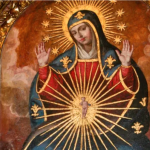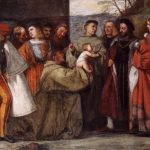Written by Kathy Clubb
When Our Lady appeared on Tepeyac hill at Guadalupe five hundred years ago, the good effects her apparition made on the culture were immediately apparent. Conversion to the Catholic faith, which had been progressing slowly up to that point, increased exponentially. The Mexican people became very devoted and faithful. Large families were common and they generously welcomed new life. The elderly were respected and sodomy, which had been commonly practised among the native elite disappeared.
Unfortunately, over the last few decades, orthodox practise of the Faith in Mexico has declined. Present-day Catholicism is tainted by syncretism and pagan deities have crept back into Mexican life. This has led to an associated increase in the hallmarks of a death culture: a steady rise in the number of abortions coupled with decreasing fertility rates, a growing openness to the LGBT movement, as well as the ubiquitous drug trade that dominates every area of life in the country. Disturbingly, atheism is growing at five times the rate of Catholicism[1] and Mexico is again one of the most dangerous countries in which to be a Catholic priest.[2]
The growth of abortion
Although the abortion-lobby makes hysterical claims of women’s inability to access that service in Mexico, abortion is available in cases of rape and when the life of the mother is deemed to be at risk. This is despite twenty of Mexico’s thirty-two states prohibiting abortion at the constitutional level. Unrestricted abortion is available in two areas during the first trimester: Mexico City decriminalised in 2007, with Oaxaca following suit in late 2019. During the first four years after decriminalisation in Mexico City, the number of legal abortions rose from around thirteen thousand to more than twenty thousand.[3] A significant number of current abortions are performed by traditional healers, reminiscent of the link between indigenous pagan religions and child-sacrifice.
Notably, the fertility rate in Mexico has declined drastically during the past few decades, coinciding with increased access to contraception and abortion courtesy of the sexual revolution, but also coinciding with the rise of Liberation Theology.
In bondage to Liberation Theology
The Virgin of Guadalupe has been co-opted by liberation theologians as a champion for the poor of South America. Drawing heavily on Mary’s Magnificat, they seamlessly integrate God’s legitimate promises to the poor with an imagined, ‘preference for the poor’ on the part of their traditional leaders. The idea of ‘poor in spirit’ is explicitly rejected and firmly replaced with physical want in this life alone. Not surprisingly, there is no mention of the historical reward for many of the indigenous poor: sacrifice at the altar of a bloodthirsty god or goddess.
One famous proponent of Our Lady as a patron for liberation theology was Fr. Virgilio Elizondo. Fr. Elizondo wrote Guadalupe Mother of the New Creation, in which he suggested that the coming of Our Lady at Guadalupe was to instruct us in a ‘spirituality of difference’ – embracing the other without being hampered by doctrine to create a ‘world without borders.’ Unfortunately, Fr. Elizondo committed suicide in 2016, after allegations of child sexual abuse were made against him. In his suicide note, he wrote that he was giving his life for the sake of anyone he had hurt, stating that his was not a suicide but rather his ‘final gift of life.’
Santa Muerte & Narco-Religion
As undiluted Catholicism has fallen from favour in Mexico, a demonic death-cult has moved into the vacuum. The country is now home to two million followers of Santa Muerte, one of the fastest-growing religions in the world. The cult of Santa Muerte – Saint Death – became widely-known about twenty years ago, and is said to be based on an Aztec goddess named Mictecacihuatl, the “Lady of the Dead”. Santa Muerte’s first modern shrine was erected in 2001 and the cult grew rapidly as it was adopted by criminals during the advent of the Mexican drug wars.
Members of drug gangs pray to Santa Muerte for protection while transporting their narcotics and some leave effigies of Santa Muerte at the sites where they kill rival gang members. Others have been known to offer animal and human sacrifice to the ‘Saint of Death.’ The Church as well as Mexican authorities have denounced the cult for its glorification of violence. Cardinal Ravisi, infamous for taking part in a public ritual to Pachamama, denounced the cult as ‘blasphemous’ and a ‘degeneration of religion.’
The cult’s devotees literally worship death and erect altars in their homes complete with statues of Santa Muerte, usually depicted as a female skeleton holding a scythe. Offerings of fruit, sweets, tequila and even heroin are made to the ‘saint’, criminals in particular have her image tattooed on their body. Processions in honour of Santa Muerte through the streets of poorer areas of Mexico are common and whole communities are devoted to her cult.
Devotees often claim to be Catholic, which means that figures showing the number of Catholics in Mexico aren’t necessarily accurate. Interestingly, in Mexico, Santa Muerte’s feast day is the feast of All Saints, and this coincides with the Day of the Innocents, when deceased babies and children and remembered.
Exorcisms are essential in order to combat the effects of these cults; many members become fully possessed through their devotion to idols, drugs and violence.
Pachamama – the goddess that won’t go away
The site of the apparition of Our lady of Guadalupe to Juan Diego is significant not only for Catholics: Tepeyac Hill was the sacred place for worship of the Aztec earth goddess, Tonantzin, also known as Coatlicue. Perhaps it is no coincidence that another name for this ancient goddess is Pachamama.
Thus it seems that the spectre of primitive South American goddesses, first introduced to the mainstream Catholic world at the Amazon synod, isn’t going to leave in a hurry. Pachamama has become a catchcry for the heterodoxy being put out in the Vatican’s name both by its proponents and opponents.
Despite support for the idea that the Pacha, Tonantzin or even Santa Muerte are inculturated representations of the Virgin of Guadalupe, the startling differences between the fruits of their cults is evidence that this theory is simply untrue. Prelates like Cardinal Schonborn, who say that Pachamama is a pro-life archetype[4] are not in touch with the reality of the death cult which has Mexico once again in its grip.
Two women are inextricably linked with the sacred hill of Tepeyac in Mexico and their battle is playing out before our very eyes. One is an amoral serpent-goddess, clothed in snakes and demanding blood sacrifice in return for her favours. The other is the virginal Mother of God, who is pictured with the demonic serpent writhing under her feet. Through this One, a flourishing culture of life was ushered into the nation, but abandonment of Her message is responsible for a modern rise in the cult of death, with its abortion, drugs and apostasy.









